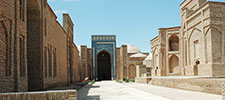Sultan-Saodat mausoleums
Illustrating the period when the Karakhanid Seljuk dynasty ruled what was called the Northern Tokharistan is the Sultan-Saodat complex, an important ensemble of mausoleums of Termez seyids, who claimed their decadence the prophet Muhammad. Four hectares in area, the Sultan-Saodat complex consists of 143 structures. The earliest mausoleum, built in the northern part of the complex, dates back to the nth century.
Hasan al Amir, the founder of Termez seyeeds clan, is buried here. The portal of this mausoleum with a square layout.; is topped with a huge dome. Soaring up at the height of 15 metres, the portal is the highest structure of the complex. In the past it was decorated with glazed tiles whose brightness and fineness can be comparable to Samarkand prototypes. The dome stands on arches and pendentives of herringbone pattern brickwork. Both the inside and the northern outside of the mausoleum have alternating large and small
niches with small corner columns. Such a design was typical of cult structures of that time. Another construction of the complex - the southern mausoleum- was built subsequently, in the late nth — early 12th centuries. The aivan mosque, which is still in good condition, dates back to the same period. Initially this place was chosen for the necropolis of emirs; but in later period other members of the royal family began to build their mausoleums here, each to his liking and resources. The last structure of the complex is the entrance portal at the end of the eastern facade. It dates back to the turn of the l5th and 18th centuries.



